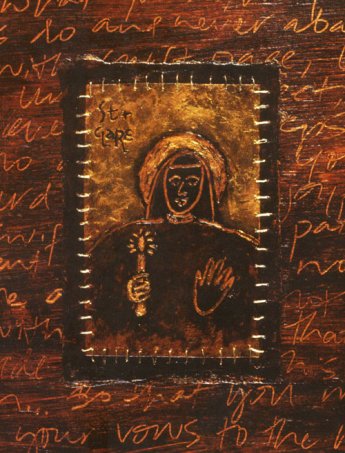
Saint Clare © Jan L. Richardson
When I became the Artist in Residence at a Catholic retreat center more than a decade ago, it was due in large measure to the hospitality of the Franciscan community that administered the center. I harbor a deep fondness for Franciscans as a result, and so August 11 is a particular day of celebration. It’s the Feast of Saint Clare, the friend and colleague of Saint Francis who became a remarkable leader in her own right.
Born in Assisi, Italy, around 1194, Clare was the third of five children born to the well-to-do Favorone family. The story is told that as Clare’s mother Ortulana anxiously prayed for her child’s safe birth, a voice called to her, “O lady, do not be afraid, for you will joyfully bring forth a clear light that will illumine the world.” When she gave birth to a healthy daughter, Ortulana and her husband named her Chiara or Clare: the clear one, the bright one.
In his book Clare of Assisi: Early Documents, Regis Armstrong relates a story about Clare that took place on Palm Sunday in 1212. He writes that “when all the young ladies of the town customarily dressed in their finest and proudly processed to the Bishop for a palm branch…Clare remained in her place, prompting him to come to her.” Although some ascribed her reticence to shyness, Armstrong suggests that this was “a symbolic gesture suggesting her renunciation of the social conventions of the time with all the vanity and appeal to wealth with which they were imbued and the Bishop’s awareness and reverence of the movement of God within her.” That same Sunday, Clare, who had befriended a radical young preacher named Francis, secretly went to Our Lady of Angels, the Portiuncula, where she made a commitment to Francis and his spiritual brothers to embrace their life of devotion and poverty.
Clare lived in several monasteries, moving more than once to avoid pressure from her family, who had sought to arrange a marriage for her. Other women later joined her, including her mother, and Clare became the leader of the Poor Ladies of San Damiano, later to be known as the Poor Clares. Clare and her sisters shared Francis’s passion for poverty, humility, and charity to all, particularly those on the margins of the affluent society in which Clare and Francis had grown up.
In a time when women’s monastic communities received various forms of protection from the church, including financial support, Clare insisted that her community have the right to poverty, trusting that the goodwill of others would provide for their needs. The church authorities resisted Clare on this point, but she refused to relent. Finally, on August 10, 1253, Clare received an approved copy of the Rule she had written for her community. Bearing the seal of Pope Innocent IV, the document ensured that the charism of poverty would remain the privilege of the community that Clare had founded. Clare died the next day.
Although tradition attached to Clare the identity of la pianticella (the little plant) of Saint Francis, she embodied her own distinct vision, one that continued to shape Franciscan life after Francis’s death. Clare’s few surviving writings reveal a deep commitment to a God-centered life, a life in which she sought to give up all that would hinder intimacy with God.
In Clare’s “Second Letter to Blessed Agnes of Prague,” she offers this blessing:
What you hold, may you [always] hold.
What you do, may you [always] do and never abandon.
But with swift pace, light step,
unswerving feet,
so that even your steps stir up no dust,
may you go forward
securely, joyfully, and swiftly,
on the path of prudent happiness,
not believing anything,
not agreeing with anything
that would dissuade you from this resolution
or that would place a stumbling block for you on the way,
so that you may offer your vows to the Most High
in the pursuit of that perfection
to which the Spirit of the Lord has called you.
And so may this be our blessing for this day. Happy Feast of Saint Clare!
Artwork: detail from “Saint Clare” © Jan L. Richardson. To use this image, please visit this page at janrichardsonimages.com. Thank you!
This reflection originally appeared at The Painted Prayerbook. Clare’s blessing is taken from Regis Armstrong’s book Clare of Assisi: Early Documents.

What a lovely post, Jan, and particularly relevant for me because I took Clare as my patron when I became an oblate last year.
Thank you, Tess! How lovely to know your connection with Clare. Blessings to you…